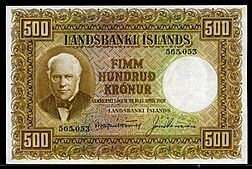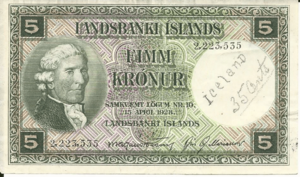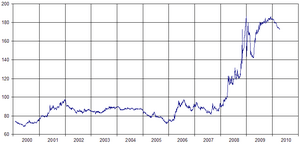Icelandic króna facts for kids
Quick facts for kids Icelandic króna |
|||
|---|---|---|---|
|
|||
| ISO 4217 Code | ISK | ||
| User(s) | |||
| Subunit | |||
| 1⁄100 | eyrir | ||
| Symbol | kr | ||
| eyrir | a | ||
| Plural | krónur | ||
| eyrir | aurar | ||
| Coins | 1, 5, 10, 50, 100 króna | ||
| Banknotes | 500, 1,000, 2,000, 5,000, 10,000 króna | ||
| Printer | De La Rue | ||
The króna (pronounced "KROH-na") is the official money of Iceland. It is also sometimes called the Icelandic crown. Its symbol is kr.
Contents
What's in a Name?
The name króna means crown. It comes from the Latin word corona, which also means "crown". Many countries in the Nordic region, like Denmark, Sweden, and Norway, have currencies with similar names, such as the Danish krone or Swedish krona. This is because they were once part of a group called the Scandinavian Monetary Union.
The First Icelandic Krona (1874–1981)
The first money used in Iceland was the Danish krone, introduced in 1874. A few years later, in 1885, Iceland started printing its own banknotes.
Iceland's money became separate from the Danish krone after World War I. This was also when Iceland gained its independence from Denmark in 1918. The first Icelandic coins were made in 1922.
In 1922, the value of the Icelandic krona was lowered by 23% compared to the Danish krone. This was the start of Iceland managing its own money system, and the krona's value changed many times after that.
For 14 years, starting in 1925, the krona's value was linked to the British pound. Then, in 1939, it was linked to the US dollar until 1949.
Early Coins
Iceland's first coins were 10 and 25 aurar (a smaller unit of money, like cents) pieces. They were made in 1922. Later, in 1925, 1 krona and 2 krona coins were added. In 1926, 1, 2, and 5 aurar coins were also made.
After Iceland became fully independent from Denmark in 1944, the designs on the coins were changed in 1946. The royal symbol was removed.
Because the krona's value dropped a lot, new coins were introduced starting in 1967. This included 10 krona coins, then 50 aurar and 5 krona coins in 1969, and 50 krona coins in 1970.
Early Banknotes
The first banknotes were printed in 1885 by Landssjóður Íslands (Iceland's National Treasury). They came in values of 5, 10, and 50 krona. In 1904, a new bank, Íslands Banki (Bank of Iceland), started printing money and added 100 krona notes.
In 1921, another government body, Ríkissjóður Íslands, began issuing paper money, with notes for 1, 5, 10, and 50 krona.
By 1928, the Landsbanki Íslands (National Bank of Iceland) took over printing notes of 5 krona and higher. The Ríkissjóður Íslands continued to print 1 krona notes until 1947. The Landsbanki Íslands introduced 500 krona notes in 1935, and then 25 and 1000 krona notes in 1957.
In 1961, the Seðlabanki Íslands became the main bank of Iceland. It started printing paper money in values of 10, 25, 100, and 500 krona. These notes were made in England.
The Second Icelandic Krona (1981–Present)
In 1981, Iceland changed its money system because of high inflation (when prices go up a lot). This change meant that 100 old krona were now worth 1 new krona. A new 500 krona banknote was released in 1981. Later, 1000 krona notes came out in 1984, and 5000 krona notes in 1986. A 2000 krona banknote was introduced in 1995, but it was not very popular. The 10,000 krona banknote was released in 2013.
Coins worth less than one krona (aurar) have not been used for many years. In 2002, the Prime Minister of Iceland decided that all payments should be in whole krona. Coins worth less than one krona were taken out of use. By 2007, the eyrir (aurar) officially stopped being a part of the Icelandic krona.
Modern Coins
In 1981, new coins were made in values of 5, 10, and 50 aurar, along with 1 krona and 5 krona. Later, 10 krona coins were added in 1984, 50 krona in 1987, and 100 krona in 1995. Since 2003, banks in Iceland no longer accept aurar coins.
| Currently circulating coins | ||||||||||
|---|---|---|---|---|---|---|---|---|---|---|
| Value | Technical parameters | Description | Issued since | |||||||
| Diameter | Thickness | Mass | Composition | Edge | Reverse | Obverse | ||||
| 1 kr. | 21.5 mm | 4.5 g (until 1989) 4.0 g (from 1989) |
Cupronickel 75% Cu, 25% Ni (until 1989) Nickel-plated steel (from 1989) |
Milled | Mountain giant | Atlantic cod (Gadus morhua) | 1981 | |||
| 5 kr. | 24.5 mm | 6.5 g (until 1996) 5.6 g (from 1996) |
Cupronickel 75% Cu, 25% Ni (until 1996) Nickel-plated steel (from 1996) |
Land wights | Two short-beaked common dolphins (Delphinus delphis) | |||||
| 10 kr. | 27.5 mm | 1.78 mm | 8.0 g (until 1996) 6.9 g (from 1996) |
Four capelin (Mallotus villosus) | 1984 | |||||
| 50 kr. | 23 mm | 2.6 mm | 8.25 g | Nickel brass 70% Cu, 24.5% Zn, 5.5% Ni |
Milled | Land wights | Shore crab (Carcinus maenas) | 1987 | ||
| 100 kr. | 25.5 mm | 2.25 mm | 8.5 g | Alternately plain and milled | Lumpfish (Cyclopterus lumpus) | 1995 | ||||
| For table standards, see the coin specification table. | ||||||||||
| Former circulating coins | |||||||||||
|---|---|---|---|---|---|---|---|---|---|---|---|
| Value | Technical parameters | Description | Issued since | Date of lapse | |||||||
| Diameter | Thickness | Mass | Composition | Edge | Obverse | Reverse | |||||
| 5 a | 15 mm | 1.5 g | Bronze 97% Cu, 2.5% Zn, 0.5% Sn |
Plain | Bird | Common skate (Raja batis) | 1981 | 1 October 2004 | |||
| 10 a | 17 mm | 2.0 g | Bull | Squid (Cephalopoda) | |||||||
| 50 a | 19.5 mm | 3 g (1981) 2.65 g (1986) |
Bronze 97% Cu, 2.5% Zn, 0.5% Sn (1981) Copper-plated steel (1986) |
Dragon | Shrimp (Pandalus borealis) | ||||||
| For table standards, see the coin specification table. | |||||||||||
Modern Banknotes
Icelandic banknotes show the dates of the laws that allowed them to be made. In 1981, notes of 10, 50, 100, and 500 krona were issued. Then, 1000 krona notes came in 1984, and 5000 krona notes in 1986.
In 1994, 100, 500, and 1000 krona notes were reissued with new designs. In 1995, a new 2000 krona note was released. This 2000 krona note looked a bit different from the others.
In 2001, more changes were made to the banknotes. Features like special printing patterns and tiny text were added to more notes. The 1000 and 5000 krona notes also got shiny metallic parts next to the pictures.
In 2013, a new 10,000 krona banknote was introduced. It features the scientist and poet Jónas Hallgrímsson and the Eurasian golden plover bird. Notes of 100 krona or less are no longer used, as the central bank has taken them out of circulation.
| Law of 29 March 1961 Series | ||||||
|---|---|---|---|---|---|---|
| Value | Dimensions | Main Colour | Description | Date of issue | ||
| Front side | Back side | Watermark | ||||
| 10 krona | 130 × 70 mm | Blue | Arngrímur Jónsson the Learned | Old Icelandic household scene based on Auguste Mayer's drawing | Jón Sigurðsson | 1981 |
| 50 krona | 135 × 70 mm | Brown | Guðbrandur Þorláksson | Printers at work in the 16th century | ||
| 100 krona | 140 × 70 mm | Green | Árni Magnússon | Monastic scribe | ||
| 500 krona | 145 × 70 mm | Red | Jón Sigurðsson | Jón at his writing desk | ||
| 1000 krona | 150 × 70 mm | Purple | Brynjólfur Sveinsson | Brynjólfskirkja church (1650–1802) at Skálholt | 1984 | |
| 5000 krona | 155 × 70 mm | Blue-green multicolour | Ragnheiður Jónsdóttir | Ragnheiður instructing two girls in embroidery | 1986 | |
| Law of 5 May 1986 Series | ||||||
| 100 krona | As previous | 1994 | ||||
| 500 krona | ||||||
| 1000 krona | ||||||
| 2000 krona | 150 × 70 mm | Brown | Jóhannes Kjarval | Kjarval's painting Yearning for Flight and his drawing Woman and Flowers | Jón Sigurðsson | 1995 |
| Law of 22 May 2001 Series | ||||||
| 500 krona | As previous, but the underprint design extends upward and downward to fill the margin | October 2005 | ||||
| 1000 krona | November 2004 | |||||
| 5000 krona | November 2003 | |||||
| 10,000 krona | 162 × 70 mm | Blue | Jónas Hallgrímsson; outlines of mountains Háafjall and Hraundrangi formed from Icelandic words coined by Jónas; floral pattern from cover of periodical “Fjölnir;” Jónas’ handwritten poem “Ferðalok” (Journey's End); topographical outline of mountain Skjaldbreiður | A plover and Hallgrímsson's poem Skjaldbreiður Mountain; topographical outline of mountain Skjaldbreiður; Jónas’ handwritten poem “Fjallið Skjaldbreiður;” scallop shell | Jón Sigurðsson | October 24, 2013 |
Challenges for the Icelandic Krona
Iceland is not part of the European Union and does not use the euro. The Icelandic krona is a currency that is not used much around the world. Its value can change quickly compared to other currencies like the US dollar or the euro. For example, in 2006, the krona's value against the US dollar changed a lot.
Before a big financial crisis in 2008, many thought the krona was worth too much.
In most shops in Iceland, you pay with electronic cards. Other currencies are almost never accepted, except at Keflavík International Airport. Some stores in downtown Reykjavík might accept foreign money.
Iceland uses computers and technology a lot. Many payments are made electronically, like with debit or credit cards. The largest banknote, the 10,000 krona note, is not worth a huge amount (about $72 US dollars in August 2024). This means most big payments in Iceland are done electronically or using other currencies.
The 2008 Financial Crisis
In October 2008, Iceland had a major financial crisis. The value of the Icelandic krona dropped very quickly. The Central Bank of Iceland tried to keep its value steady against the euro, but they had to give up. The krona's value fell even more.
This crisis made things much cheaper for foreign visitors and businesses. For example, in July 2008, a Big Mac burger cost almost $6 US dollars in Iceland, but only $3.57 in the US.
Iceland and the Euro
Some people think that if Iceland used the euro, it would help the country avoid big changes in its money's value. Before the crisis, some economists thought the euro could bring lower interest rates, which would help businesses grow. It might also make prices lower by making it easier to compare costs with other countries that use the euro.
There are different opinions in Iceland about using the euro. Some polls have shown that many Icelanders would like to adopt the euro, while others are against it. After the financial crisis, some officials said that the krona was "dead" and that the euro was the only real choice.
In 2009, Iceland's parliament voted to apply to join the European Union, which would mean adopting the euro. However, this application has been paused since 2013. As of 2015, Iceland has no plans to continue joining the EU or to adopt the euro. The current government leaders have said the krona will remain Iceland's money for now.
Using Another Country's Money
Some small countries, like El Salvador, have decided to use another country's money (like the US dollar) to help control inflation. This means they lose control over their own money policies.
In 2012, there was talk about Iceland using another country's money. The idea of using the Canadian dollar was popular because Canada is also a northern country with a similar economy. However, officials from the Central Bank of Iceland said that using another currency would be very expensive and might not be the best choice unless joining the European Union was completely off the table.
As of 2018, Iceland does not plan to use a foreign currency.
Exchange Rate
- As of August 31, 2024, 1 US dollar was worth about 138.40 Icelandic kronur.
| Current ISK exchange rates | |
|---|---|
| From Google Finance: | AUD CAD CHF EUR GBP HKD JPY USD DKK NOK SEK |
| From Yahoo! Finance: | AUD CAD CHF EUR GBP HKD JPY USD DKK NOK SEK |
| From XE.com: | AUD CAD CHF EUR GBP HKD JPY USD DKK NOK SEK |
| From OANDA: | AUD CAD CHF EUR GBP HKD JPY USD DKK NOK SEK |
| From fxtop.com: | AUD CAD CHF EUR GBP HKD JPY USD DKK NOK SEK |
See also
 In Spanish: Corona islandesa para niños
In Spanish: Corona islandesa para niños
- Economy of Iceland
- Scandinavian Monetary Union
- Auroracoin





